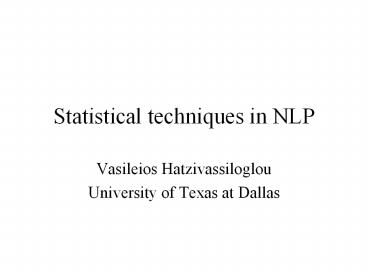Statistical techniques in NLP - PowerPoint PPT Presentation
Title:
Statistical techniques in NLP
Description:
Statistical techniques in NLP Vasileios Hatzivassiloglou University of Texas at Dallas Learning Central to statistical NLP In most cases, supervised methods are used ... – PowerPoint PPT presentation
Number of Views:188
Avg rating:3.0/5.0
Title: Statistical techniques in NLP
1
Statistical techniques in NLP
- Vasileios Hatzivassiloglou
- University of Texas at Dallas
2
Learning
- Central to statistical NLP
- In most cases, supervised methods are used, with
a separate training set - Unsupervised methods (clustering) recalculate the
entire model on new data
3
Parameterized models
- Assume that the observed (training) data D is
described by a given distribution - This distribution, possibly with some parameters
?, is our model ?. - We want to maximize the likelihood function,
P(D?) or P(D?).
4
Maximum likelihood estimation
- Find the ? that maximizes P(D?), i.e.,
- Example Binomial distribution
- P(Dm)
- Therefore, mD/N
5
Smoothing
- MLE assigns zero probability to unseen events
- Example trigrams in part of speech tagging (23
unseen) - Solution smoothing (small probabilities for
unseen data)
6
Bayesian learning
- It is often impossible to solve
- Bayes decision rule choose ? that maximizes
P(?D) (minimum error rate) - But it may be hard to calculate P(?D)
- Use Bayes rule
- Naïve Bayes
7
Examples
- Gale et al 1992, 90 sense disambiguation
accuracy (choose between bank/money and
bank/river) - Hanks and Rooth 1990, prepositional phrase
attachment - He ate pasta with cheese
- He ate pasta with a fork
- Both rely on observable features (nearby words,
the verb)
8
Markov models
- A stochastic process follows a sequence of states
over time with some transition probabilities - If the process is stationary and with limited
memory, we have a Markov chain - The model can be visible, or with hidden states
(HMM)
9
Example N-gram language models
- Result for a word depends only on the word and a
limited number of neighbors - Part-of-speech tagging maximize
- With Bayes rule, chain rule, and independence
assumptions - Use HMM for automatically adjusting back-off
smoothing
10
Example Speech recognition
- Need to find correct sequence of words given
aural signal - Language model (N-gram) accounts for dependencies
between words - Acoustic model maps from visible (phonemes) to
hidden (words) level - HMM combines both
- Viterbi algorithm will find optimal solution
11
Estimation-Maximization
- In general, we can iteratively estimate complex
models with hidden parameters - Define a quality function Q as the conditional
likelihood of the model on all parameters - Estimate Q from an initial choice for ?
- Choose new ? that maximizes Q
12
Example PCFG parsing
- Probabilistic context-free grammars
- Likelihood of each rule (e.g., VP ? V or VP ? V
NP) is a basic parameter - Combined probability of the entire tree gives the
quality function - Forward-backward algorithm gives the solution
- Lexicalization (Collins, 1996, 1997)
13
Example Machine Translation
- The noisy channel model (Brown et al., 1991)
- Input in one language (e.g., English) is garbled
into another (e.g., French) - Estimate probabilities of each word or phrase
generating words or phrases in the other language
and how many of them (fertility) - A similar approach Transliteration (Knight, 1998)
14
Linear regression
- Predict output as a linear combination of input
variables - Choose weights that minimize the sum of residual
square error (least squares) - Can be computed efficiently via a matrix
decomposition and inversion
15
Log-linear regression
- Ideal output is 0 or 1
- Because the distribution changes from normal to
binomial, a transformed LS fit is not accurate - Solution Use an intermediate predictor ?,
- Can be approximated with iterative reweighted
least squares
16
Examples
- Text categorization for information retrieval
(Yang, 1998) - Many types of sentence/word classification
- cue words (Passonneau and Litman, 1993)
- prosodic features (Pan and McKeown, 1999)
17
Singular-value decomposition
- A technique for reducing dimensionality data
points are projected - Given matrix A (n?m), find matrices T (n?k), S
(k?k), and D (k?m) so that their product is A - S is the top k singular values of A
- Projection is achieved by multiplying and A
- Application Latent Semantic Indexing
18
Methods without an explicit probability model
- Use empirical techniques to directly provide
output without calculating a model - Decision trees Each node is associated with a
decision on one of the input features - The tree is built incrementally by choosing
features with the most discriminatory power
19
Variations on decision trees
- Shrinking to prevent over-training
- Decision lists (Yarowsky 1997) use only the top
feature for accent restoration
20
Rule induction
- Similar to decision trees, but the rules are
allowed to vary and contain different operators - Examples RIPPER (Cohen 1996), transformation-base
d learning (Brill 1996), genetic algorithms
(Siegel 1998)
21
Methods without explicit model
- k-Nearest Neighbor classification
- Neural networks
- Genetic algorithms
22
Support vector machines
- Find hyperplane that maximizes distance from
support vectors - Non-linear transformation From original space to
separable space via kernel function - Text categorization (Joachims, 1997), OCR (Burges
and Vapnik, 1996), Speech recognition (Schmidt,
1996)
23
Classification issues
- Two or many classes
- Classifier confidence, probability of membership
in each class - Training / test set distributions
- Balance of training data across classes
24
When to use each method?
- Probabilistic models depend on distributional
assumptions - Linear models (and SVD) assume a normal data
distribution, and generalized linear models a
Poisson, binomial, or negative binomial - Markov models capture limited dependencies
- Rule-based models allow for multi-way
classification easier than linear/log-linear ones - For many applications, it is important to get a
confidence estimate































